
THE MAGAZINE OF SONOMA STATE UNIVERSITY | SPRING 2024

SSU Solar Array Could Save Campus
$6 Million
SSU’s solar array project, projected to provide onethird of the campus with clean, renewable electricity, is the most ambitious initiative in the SSU Climate Action Plan and is projected to save the campus $6 million over 30 years.
By 2025, the array will produce enough extra energy to run three areas on campus: the Emergency Operations Center, the Student Center Main Kitchen, and the Recreation Center, all serving shelter-in-place purposes and emergency operations needs.
With numerous initiatives in place – from recycling to zero waste and LEED certification – the university is committed to achieving carbon neutrality and creating a sustainable, resilient campus.

On the Cover
Stevenson Hall is the centerpiece of the 269-acre Sonoma State University campus and is the largest academic building at SSU, making it an intrinsic part of the lives of faculty and students.
More than 60 years after its creation, Stevenson Hall has seen many changes from a campus and academic perspective.
Originally a symbol of Sonoma State’s status as a four-year college, Stevenson Hall served as a hub for faculty, staff, and administrative offices. Since then, it has housed multiple academic departments and schools, including the School of Business and Economics, the School of Education, and the School of Social Sciences.
The offices of the President, the Provost/Academic Affairs, and Advancement and Alumni Relations once called Stevenson home, and in the 1960s, it even supported a small campus cafeteria.
A stunning $90-million renovation completed in 2022 transformed the Hall from a loveable, ivy-covered concrete bunker into the first state-of-the-art, LEED-certified building on campus.
“Stevenson Hall is and will always be a true hub for dialogue and academic endeavors,” President Lee said at the 2023 ribbon-cutting ceremony, raising a pair of giant scissors as the crowd roared with appreciation.
What’s inside?
Features
Preserving and Renewing Tradition
With the aid of the Federated Indians of Graton Rancheria, the refurbished Fairfield Osborn Preserve is an educational foothold on a mountain held sacred by Coast Miwok and Southern Pomo tribes.
SEEDS Sprouts
Community-Minded Teachers
SSU program creates specialeducation experts – and a heartfelt community of educators.
Learning by Making
SSU faculty and staff in EdEon STEM Learning didn’t have the technology they needed to innovate science instruction in rural and underserved schools. So they built it.
On the Theme of Renewal
President Ming-Tung ‘Mike’ Lee
Awards & Milestones
Honorary Degrees
Research Roundup
Exploring Gullalh culture, the sun’s secrets, and habitat restoration by hungry otters
Strategic Enrollment Vice
President Dr. Ed Mills
Alumni and Advancement
1 Insights Spring 2024
16 18 20 2 4 6 11 12 14 24
Aerial view of campus and solar array looking east over University housing -- Tuscany and Beaujolais villages.
Spring 2024
President
Ming-Tung “Mike” Lee, Ph.D.
Chief of Staff & Vice President, Strategic Initiatives and Diversity
Jerlena Griffin-Desta,
Ph.D.
Editor
Associate Vice President for Government Affairs & Strategic Communications
Jeff Keating
Managing Editor
Janet Durkin
Contributors
Brennan Chin
Sandy Destiny
Brittany Eldred
Tiffany O’Neil
Krista Sherer
Cover Design
Brennan Chin
Published by Strategic Communications
Sonoma State University
Rohnert Park, CA 94928-3609
“Insights” welcomes your feedback and input. Emails to the editor should be sent with the writer’s name, graduation year (if an SSU alum), address, and daytime phone number to stratcomm@sonoma.edu
Renewal marks the path to SSU’s future
Karen Moranski, Provost and Vice President for Academic Affairs
Monir Ahmed, Vice President for Administration and Finance
Some moments in human history shift the ground beneath us and signify a change of such magnitude that our lives are forever different. When “Insights” magazine was published in Spring 2020, the world was experiencing such a moment. As “Insights” went to print, the world – and Sonoma State – was going into hibernation as we faced the COVID-19 virus.
Meaningfully, the theme of that Spring 2020 issue was sustainability and resilience, and that is what this new issue of “Insights” represents. Profound change is the order of the day in our lives, in our work, and in higher education. The good news, however, is that in 2024, resilience – our ability to seek renewal and a sustainable future – is the continued story of Sonoma State.
In the years before the pandemic, Sonoma State prided itself on providing a highimpact, in-person experience. We had begun our journey as a Hispanic Serving Institution with an increasingly diverse student population. We met our assigned enrollment targets and our budget was relatively stable. With the highest residential student population in the California State University, we were making excellent progress toward meeting our graduation targets and lowering our equity gaps. We had just signed, as “Insights” magazine detailed, the President’s Climate Leadership Commitment, and we had a relatively new strategic plan that focused on priorities like Student Success and Academic Excellence, and core values like Diversity and Social Justice and Sustainability and Environmental Inquiry.
What we did not know was that another of our Core Values – Adaptability and
Responsiveness – might emerge as the most important. With the pandemic came enrollment decline, particularly of our out-of-region student population, and a resulting budget impact. Today, in 2024, we have a much smaller student population and fewer staff and faculty than before the pandemic. We are reorganizing the way we work. Our campus, however, is once again vibrant, our residence halls are beginning to fill as new student enrollment starts to increase, and we now know we can teach online successfully and that some of our students want to learn that way.
Today, renewal is guided by a leadership team headed by President Ming-Tung “Mike” Lee, who arrived in August 2022 and created a new position -- Vice President for Strategic Enrollment Management (see story, page 16). The campus is making progress on enrollment by developing deeper relationships with P-12 school districts and community colleges and experimenting with digital marketing techniques that reach students on their phones.
Academics is undergoing a profound transformation through an Academic Master Planning process that is focusing on our Hispanic-serving and liberal arts missions, seeking new and better ways to deliver courses and student services, and building our current and new academic programs to serve the next generation of students through interdisciplinary problem-solving. Student success now means both retaining and graduating our students, addressing their mental health and basic needs, and connecting career pathways to every major. And student engagement is increasing

2
Printed with soy inks on recycled content paper
sonomastateuniversity Sonoma State University
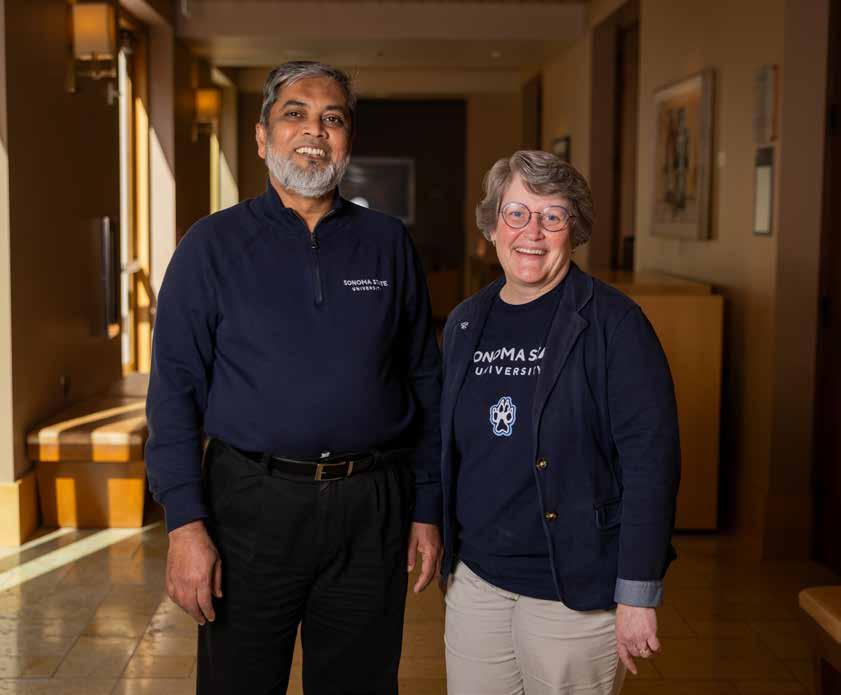
– just look at our athletics teams, who are creating a new campus spirit with their incredible success this past year!
Renewal is also happening for the physical campus as we upgrade aging infrastructure, including buildings, technology, and accessways, as well as safety services and protocols to support a new academic environment that is agile and adaptable to new learning modalities. The soon-to-be completed solar array brings the campus to a new level of sustainability and makes it less dependent on power supplied by utility companies for its core operations during an emergency. The Stevenson Hall remodel has energized the whole campus with its new digital classrooms and its student and faculty collaboration spaces.
The campus multi-year budget planning process has been revamped to offer more predictable resources needed in the near future. The budget process will continue to
incorporate various performance metrics and benchmarks to help prioritize our investment in the coming years.
We are pushing forward on the sustainability front, as exemplified by Stevenson Hall’s renovation as a LEED Gold building. Our new Earth Week program, Seawolves Dig In, provides education about Sonoma State’s efforts to encourage native plant growth while developing partnerships between our students and our incredibly hard-working Facilities team.
Sonoma State continues to work through challenges, but renewal is our guiding pathway, and we are leaning into our core strengths and values as we race toward the future.
3 Insights Spring 2024
Monir Ahmed (left), Vice President for Administration and Finance/CFO, and Dr. Karen Moranski, Provost, Vice President for Academic Affairs, and Chief Academic Officer at Green Music Center on Decision Day 2024.
‘The University is a power source’
SSU president draws on tradition, pride, and his own life experience to push the campus to new heights
Ming-Tung “Mike” Lee quickly recognized three things when he came to the Sonoma State University campus as interim president in 2022: The school had a rich and proud tradition of academic excellence and community service. It was in a beautiful location.
And the third, arguably most important thing? “What I discovered very quickly is that the source of that pride and tradition is really rooted in the faculty and staff,” he said.
Lee – named permanent president of SSU in May 2023 – certainly was no stranger to The California State University when he arrived at Sonoma State. During a 28-year career at Sacramento State University, he held several leadership roles, including vice president for administration and business affairs/CFO, as well as interim provost and vice president for Academic Affairs. He continues to hold emeritus status as a professor of business administration.
In fact, Lee was well into the fourth year of his retirement from the CSU when then-Interim Chancellor Jolene Koester asked him to consider leading SSU, succeeding President Judy Sakaki. Having familiarity with the campus – and seeing an opportunity to bring new energy and new ideas to a university where enrollment had dropped sharply over the previous few years – Lee accepted. He and his wife, Fei, moved into one of SSU’s two-bedroom campus apartments and quickly became entrenched, and popular, members of the university community.
“What I saw when I came here was the reality of many years of enrollment declines and the corresponding budget situation that we have to deal with,” Lee said. “But I had studied and carefully read a lot of the history, and talked to a lot of people on campus, and that allowed me to build my understanding and realize that that hope, that pride, had not been lost.
“So it became clear that my job and the job of the leadership team on this campus is to bring that back – not in the sense of recreating the past, but to give it a new life.”
Dr. Ed Mills, Sonoma State’s Vice President for Strategic Enrollment Management, who joined SSU in August 2023 at Lee’s invitation, knew Koester had asked the right man to take on the job of president.
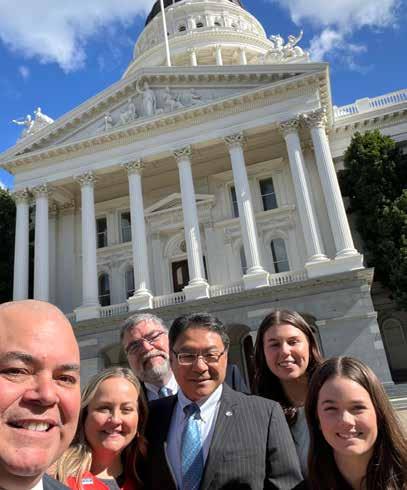
“He knew what the challenge was and what the opportunity was,” said Mills, who worked with Lee for 16 years at Sacramento State. “His leadership and experience in so many areas are a perfect fit for this role. He makes those around him want to work with him and for the mission of the university.”
Generating and sustaining that energy and sense of purpose are essential to Sonoma State’s continued evolution and growth, Lee believes.
“That’s why I think about renewal,” Lee said. “(It) allows us to really reflect on all the things that we do, – academics, operations, sports, student life, fundraising, community support, government relations – every single piece.”
Lee himself is reflective when he thinks about the journey that led him into the world of U.S. higher education. He has always loved books, but life in a small Taiwanese village with limited family income made it hard to access them, though he credits his parents with making every effort to help. It was only when he traveled all the way across the country to attend Tunghai University that the breadth and depth of what education had to offer was powerfully underlined – by a smell.
“I’d never been to a university campus. And I walked into the library, and it happened to have this open-shelf library, just full of books. And instantly the smell of this hit me – the smell of all those books – and I was in a state of euphoria.
4
President Mike Lee travels to Sacramento with students and staff for legislative visits, and (right) joins students for campus events.
“It communicated knowledge. It was the answer to my forever-eternal curiosity. As a child, I wanted to read, I wanted to learn, I wanted to know things. But I never had the money to get the books I wanted.
“So in some way, walking into the library was also a symbolic entry into a totally different world. And I know, many, many years later, how much entry into that world changed me and changed my family, changed the trajectory of my family for generations to come.
“It’s really that moment that continues to define what I think about the university.”
Lee sees his chief responsibility as ensuring that this same access to knowledge is available to all who seek it.
“If you go back to the mission of the CSU, it’s to provide very accessible, high-quality education to students. We have the same mission, of course, but there’s something about Sonoma State that stands out,” he said “It’s a peaceful, quiet, setting that very naturally allows students to pursue their academic life here in a beautiful environment.”

SSU professors care tremendously about their students, Lee said, and take the time to get to know and work with them. Students and faculty do research side by side, and work together in labs.
“They built this tradition of a close connection. And I think that’s a fundamental reason why we have an outstanding graduation rate,” Lee continued. “Certainly, graduation rate is not the only indication of student success. But it’s very important, because if the entire educational system in the university is able to generate that outcome, and students are able to get through their journey and receive their degree, it’s showing that this system actually works.
“And the system, of course, means all the people who make it work.”
University leadership also means taking a leadership role in the many communities the university serves and in steering community conversation to what an asset the university is, and how it can help on a variety of levels, Lee said.
“Any community that has a university has a power source. We are that entity in this community. An intellectual
center, a cultural center, a place for learning, a platform for knowledge pursuit. Advancement of what we know about the universe. We are the place where a lot of the exchange of ideas, opinions, and discussion can take place. And we are an economic engine for a region, and will continue to be.”
Lee said that when he arrived and started getting out into the community, he heard a lot about what a “hidden gem” SSU is. Situated just outside the southeast city limits of Rohnert Park, and surrounded mostly by trees, the campus is something of an unknown known – great reputation, friendly and engaged students, faculty, and staff, beautiful surroundings – that could stand more exposure.
“Coming from a marketing professor background, I know there’s a disconnect. So it is our job to get out there, to build that connection. You have a great product, you need to find a way to connect to people who would love to have it.”
“Renewing” the university puts into effect a word Lee uses frequently: hope.
“It’s important for people to know that I see hope. I’m here to see what we can do to put it together. Being transparent, asking for suggestions, asking for advice is a way to make sure that everybody here all feels that they’re part of it – that it’s not just the president behind a closed door trying to figure it out.”
Chico State University President Steve Perez, who has known Lee since 2001, when both men worked at Sacramento State, said Lee is an ideal fit for the challenges and opportunities at Sonoma State.
“We share a deep passion for what we do at our universities and for our students,” Perez said. “(Lee) is super smart, super caring, kind, and mission-driven. Coming up through academics and then going into administration, he knows how things work from all sides.
“Sometimes that means you have to make hard choices, but that’s what is needed so that our students can do well and our colleagues can have good lives.”
As Sonoma State University celebrates its 63rd anniversary, the president had thoughts about what he hopes will be said about the university 63 years from now.
“It’s an example of how a public university can fulfill its mission and also create unique characteristics that are consequential for transformative education, for students who come from all backgrounds to be able to change for the better – for themselves, for their families, for the generations after them,” he said.
And as new generations transform, so does SSU.
“The story of this whole process, the journey that we’re going through – this renewal – is going to be a white paper all its own,” Lee said with a laugh.
“It’s a demonstration of our tradition, of how our strengths come forward.”
- Jeff Keating
5 Insights Spring 2024
Prestigious CSU Awards shine light on outstanding SSU students, educator
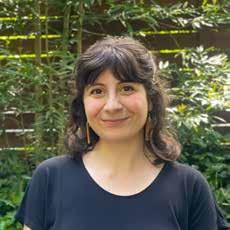

Sonoma State students
awarded top CSU scholarships
SSU students Ruzanna Gasparyan and Ismael Lopez are 2023 recipients of the prestigious Sally Casanova Scholarship, awarded annually to only 75 students among the 23 CSU campuses. The award provides each recipient with a $5,000 stipend that supports their professional development and exploration of doctoral programs.
“With the funding, I’ve started to learn what it means to be a scholar. It enabled me to join professional affiliations and both conduct [my own] and contribute to other research projects,” said Lopez, a first-generation college student who plans to get a Ph.D. in sociology. “I’ve been asked to present my research at regional sociological conferences in Washington, D.C. and San Diego.”
Armenia-born Gasparyan is exploring Ph.D. programs in Soviet history, an interest that took hold as an undergraduate at Sonoma State. Now an SSU graduate student, she said the scholarship helped her complete key research for her thesis at Stanford’s Hoover Institution; attend a convention and meet scholars from around the world; and visit doctoral programs on the East Coast and elsewhere.
“My mentor, Dr. Stephen Bittner, has been a great source of support. All the faculty in the history department are phenomenal mentors – not only to me, but to everyone in the program,” Gasparyan said.
SSU’s Angelo Incitti earns 2023 CSU Trustees’ Award
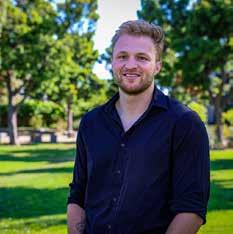
Angelo Incitti of Sonoma State was selected as the Trustee Emeritus Kenneth Fong Scholar among the 2023 CSU Trustees’ Awards for Outstanding Achievement, one of the top honors students can achieve.
“I aim to make meaningful contributions in the California conservation field,” said Incitti, who now studies environmental disturbances on marine mammals with the National Marine Mammal Foundation.
Hired as a farmhand at Curbstone Valley Farm in the midst of the pandemic, Incitti was mentored by a veterinarian and celebrated research scientist who fueled his passion to become a research biologist.
“Angelo is a model of what we idealize as the highest benefits of a CSU education –service, research, learning, and benefit to the community at large,” SSU President Mike Lee said in his letter nominating Incitti. Lee praised him for overcoming obstacles to achieve his educational goals.
6
Ruzanna Gasparyan
Ismael Lopez
Ruzanna Gasparyan
Angelo Incitti


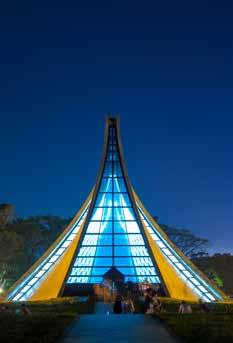
Professor Daniel Crocker receives Wang Family Excellence Award
Professor of Biology Daniel Crocker was recognized as a 2024 recipient of the Wang Family Excellence Awards for Outstanding Faculty Scholarship. The highly selective awards honor CSU faculty members “who have distinguished themselves through extraordinary dedication and exemplary achievements in their academic disciplines, while significantly contributing to the success of students.”
Crocker’s award cites his “nearly unparalleled record on campus for successful research funding, bringing in nearly $8 million in capacity-building, transforming the university’s biology program,” and his commitment to mentoring and training students.
“I give credit to the over 40 graduate students and hundreds of undergraduates who worked on the research projects. Their passion, enthusiasm, and willingness to work long hours and try new things are directly responsible for my research productivity and success,” Crocker said.
In the works: SSU student exchange with Tunghai University
Sonoma State students have access to a summer “minimester” program in Taiwan thanks to a new exchange program being developed between SSU and Tunghai University, Taiwan’s oldest private university and SSU President Mike Lee’s alma mater.
Tunghai is offering comprehensive scholarships, including travel, for two students to attend Summer Minimester, a program sponsored by Fulbright Taiwan, the Consortium for Study Abroad in Taiwan, and Tunghai University International College.
Selected students will spend five weeks in Taiwan taking classes for college credit in English with other college students from across the U.S. and the world. Lowincome and historically underrepresented students have been encouraged to apply for the Summer 2024 program. SSU faculty are being invited to teach courses in the Minimester in summer 2025.
7 Insights Spring 2024
Tunghai University in Taiwan
Dr. Crocker and students remove tracking instruments from sedated sea lion.
Milestones
“Art from the Heart” Celebrates 40 Years

SSU Holocaust & Genocide Lecture Series turns 40

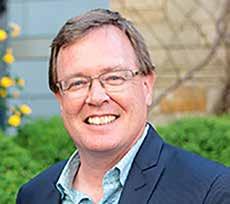
Get to Know...
Dr. David McCuan
Professor, Political Science
What I teach: American Politics (Elections) and International Relations (Political Violence & Terrorism)
The University Art Gallery’s “Art from the Heart” (AFTH) benefit auction celebrated its 40th anniversary in February 2023, attracting 450 guests and raising $19,500 for arts programs.
Among more than 100 artists included in this year’s auction were works by the late Jack Stuppin, LA-based artist Mineko Grimmer, legendary printmaker and SSU Emeritus Studio Art Professor Shane Weare, renowned Bay Area painter and SSU Emeritus Studio Art Professor Mark Perlman, and two artists recently exhibited in the deYoung Open Exhibition:
“Can we make ‘never again’ more than a slogan? Can we make it a lived reality?” said Genocide scholar and author James Waller, addressing 200-plus attendees at the 40th Anniversary of the SSU Holocaust and Genocide Lecture Series.
Considered “a unique and essential program” by the genocide studies community, the lecture series is both a semester-long credit course for students and a free public forum. Over four decades, it has brought Holocaust and genocide survivors, liberators, and worldrenowned scholars to Sonoma State.
How long have you been at SSU?
I am an alum of SSU! I have been at SSU since Fall 2003. I started as an Adjunct in 1999 while serving as an Assistant Professor at Cal Maritime.
Last book you’ve read “Disproven” on the Trump campaign and fraudulent vote claims in the 2020 election.
Favorite TV or streaming show/podcast/movie
So many to choose from! Big Fan of “The Chair” on Netflix and the “True Detective” series. And if there’s a podcast on politics, I listen. I am engaged in all things politics, 24/7. Why did you choose your profession?
I love, love, love our students, and I enjoy engaging with them in and out of the classroom. I learned so much from Political Scientists like Cheryl Petersen (one of the founding faculty of Sonoma State College)
Patrice Wachs and Eileen Parent, SSU Studio Art lecturer and BFA alumna.
The first AFTH fundraising event was organized around Valentine’s Day, according to its founder and then gallery director, SSU Emeritus Art Professor Bob Nugent, a world-renowned artist.
“I asked my artist friends to send me a valentine. Something small, like a postcard or a work on paper, that would fit into a normal-sized envelope. For their contribution I sent each artist a T-shirt with a small heart on it.” That tradition has continued.
At a reception where posters of all the speakers lined the walls, current and past speakers, family members, organizers, and participants greeted and embraced each other in an emotional reunion.
Event speakers included emcee Dean of Social Sciences Troi Carleton, Holocaust survivor Rena Victor, President Mike Lee, past series coordinator Professor Diane Parness, Petaluma Vice Mayor Janice Cader Thompson, and members of both the Federated Indians of Graton Rancheria and the Alliance for the Study of the Holocaust and Genocide.
and others, like Andy Merrifield and Robert McNamara. The ability to give back based on their inspiring work is a dream come true.
Favorite band/type of music
I am a huge fan of the blues and love Junior Wells and Buddy Guy, among so many others. Gotta love the harp with that guitar, man.
A memorable moment with students
I took a group of about 15 students to cover the first Obama Inauguration in January 2009. We spent almost three weeks in D.C. living history and enjoying that moment. Why SSU is a good place for you The people here are so deeply committed to quality education that it is not really a job, and the location is great, too. It’s a passion that binds us all together and what keeps me here. Who would ever say that about those of us who live, breathe, and study politics? Hah!
8
President Lee (right) greets guest at 40th Anniversary Lecture
Art from the Heart 40th exhibit
Seeking variety among the varietals
SSU alumni emphasize the importance of diversity in the wine business
When discussing diversity in the wine industry, Derek Baljeu, a graduate student of Sonoma State’s Wine Business Institute, said, “You need to see, to be,” regarding the need for representation in a predominantly white and male business.
“Having people that look like you in positions or places where you want to be is hugely important, and that could be indirect, like seeing someone in an article and helping them to think, ‘Hey, you know what, if he is breaking into the industry, then I can too,’” Baljeu said about his desire to inspire more diversity in the wine industry.
With only 1 percent Black-owned wineries out of the 11,000 in the country, it is easy to understand why Baljeu wants an increased blend of demographics in the wine sector.
“I cannot think of any people of color coming my way through the industry. It was just trial by fire, and I was lucky to have some amazing opportunities and make the most out of them,” he said.
Vincent Morrow has a charge similar to Baljeu, graduating from SSU with a B.S. in Business Administration and a dual concentration in Wine Business and Marketing.
Currently the Master Sommelier
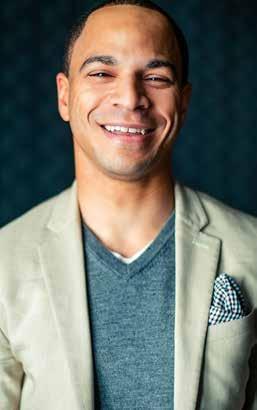
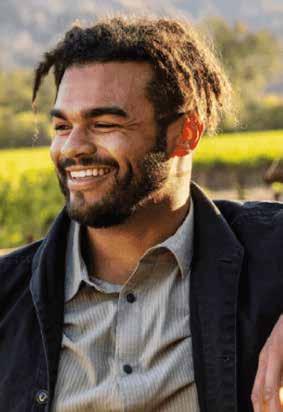
and Beverage Director at Press in Napa, Morrow is one of four Black master sommeliers in the world and is working to increase equitable solutions through the diversity committee of the Court of Master Sommeliers.
“We offer the first-level sommelier course free to beverage and hospitality students who are attending our partner universities with a historically underrepresented population, be it a Historically Black College and University or school with a generally underserved demographic,” said Morrow, referencing the Court’s diversity committee’s work.
Morrow said although the Court is a global organization, the master sommelier test has always been in English. To remove barriers to access, the committee has plans to translate the exam into numerous languages.
“It may not even occur to outside observers, but it is quite complicated when you have to do that extra computation and convert it to your native language,” Morrow said.
“I’m just a man in a cave,” said Baljeu of his role as winemaker for Knights Bridge Winery in Calistoga.
He said his team at the winery has noticed his transformation since attending WBI.
“The company has noticed a change in how I think,” he said. “At the Wine Business Institute, you are surrounded by like-minded people, some on the business side, some on the marketing side, some on the winemaking side. It opens up such a wide perspective for you.”
Mentorship is steeped in the tenets of the Court of Master Sommeliers and is offered to aspiring sommeliers of all levels several times per week. Morrow is wrapping up a nine-month mentorship through the James Beard Foundation with a student who aims to open a wine bar in Los Angeles.
“Even though you are heading somewhere, it’s important to help lift others up with you,” he said.
Also committed to the growth and development of mentoring, Baljeu works with The Roots Fund, a nonprofit created to nourish and enrich the lives of communities of color in the wine world. Baljeu said he enjoys helping his mentees through their trials and tribulations while supporting their journey into the wine industry.
“Just having somebody who has been through circumstances similar to yours is always helpful,” he said.
- Krista Sherer
9 Insights Spring 2024
Derek Baljieu
Vince Morrow, one of only four Black sommeliers in the world.

SSU Geology Department field experience & mentorship creates student opportunities
Starting in Auckland and traveling to the North and South Islands of New Zealand, SSU Geology student Kelsey Dowdall said her fieldwork experience gave her better tools than anything she could have learned in the classroom.
“I’ll never forget what I saw in that field camp. I will never forget that I remember almost every formation name,” Dowdall said.
Hiking through mountains, glaciers, and beaches of breathtaking sites like the Tanga River, Tongariro Alpine Crossing, New Plymouth, and Mount Cook, Dowdal and her camp sometimes experienced 70-mph winds and torrential rain.
“It was one of the rainiest summer seasons they have had,” she said. “But it was an amazing trip.”
With 66 days of fieldwork available for a bachelor of science degree in geology, the hands-on geology fieldwork experience sets the department apart from others in the CSU system, and beyond.
“Fieldwork prepares you for working in groups of people who are older and
younger, and most importantly, it helps you with communication, which can be the hardest when you’re in the field and on the job,” Dowdall said of the additional skills fieldwork gave her.
Dowdall said the size of SSU’s geology department – a tight-knit group of students and faculty – makes it unique.
“It allows you to have such a great connection with professors and not just be another name on their sheet,” she said.
Dowdall affectionately calls the department a family, one where professors are on a first-name basis with their students. The relationship between students and faculty is one of mentorship.
“Having the ability to have a mentor instead of just a professor is really amazing and special,” Dowdall said. “It leads to way more opportunities.”
Mentored for a year by Matty Mookerjee, Professor and Chair of the SSU Department of Geology, the student and professor worked together on a rock deformation project which they later presented at the world’s
largest annual geoscience conference, the American Geophysical Union.
“It was a big deal and we had a really good time,” a delighted Dowdall said.
Both Mookerjee and Dowdall agreed that geology might be the right calling for those seeking job security.
“You’re always going to need a geologist,” Dowdall said. “There is always a house being built. There is always going to be resources needed. There’s always going to be disasters that need to be fixed and or prevented.”
Not only do geologists work with rocks, soil, and earth, they work in chemistry and physics.
Mookerjee said that although the study of geology uses science, chemistry, and technology to understand the earth, geology is not any one science in particular.
“It’s about the question of how we understand the planet that we live on,” he explained. “I think we have a very vital role in solving the world’s problems.”
- Krista Sherer
10
SSU Geology student Kelsey Dowdall (middle, blue jacket) with her fieldwork team on the Hooker Valley Track in New Zealand.
Sonoma State
Honorary
Degree
Recipients for 2024

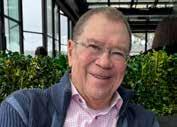

Get to Know...
Dr. Robert Eyler Professor of Economics
2024 Recipients: Greg Sarris and Larry Brackett
Dr. Greg Sarris, chairman of The Federated Indians of Graton Rancheria, and Larry Brackett, who owned and operated one of the largest real estate firms in the region, both will receive Doctor of Humane Letters (LHD) degrees at the 2024 Commencement.
Sarris was the Endowed Chair in Native American Studies at Sonoma State for 18 years, until 2022, and in 2023 was named Distinguished Chair Emeritus. Under his leadership, the Federated Indians of Graton Rancheria has provided Sonoma State University nearly $8 million. This significant support has renovated the learning center at SSU’s Fairfield Osborn Preserve, located on the tribe’s native homeland; funded the annual Summer Bridge program; endowed a professorship in Native American Studies; and brought an important collection of art by Joan Baez to the university. Sarris also served as a board member for the Green Music Center.
Sarris was born and raised in Santa Rosa, graduating from Santa Rosa High School. He attended Santa Rosa Junior
What I teach: Classes focused on macroeconomics
How long have you been at SSU? Since fall 1995.
Last book you’ve read?
“American Prometheus” (the book that is the basis of movie “Oppenheimer”)
Favorite TV or streaming show/podcast/movie?
“The Godfather,” for 100 reasons that hold for millions of other people as well.
Favorite band/type of music?
I tend to listen to the genre called “Yacht Rock,” which reminds me of being a kid and also makes for mellow listening against the chaos of life.
Why did you choose your field? Economics (to me) is an amalgam of physics, accounting, and history, three subjects with which I always seemed to connect when I was 18. I took a class in basic macroeconomics as a college freshman, saw that blend, and decided pursuing economics was for me.
College, then transferred to UCLA, where he graduated with his bachelor’s degree in English. He went on to receive his master’s and Ph.D. degrees from Stanford University. He was a full professor of English at UCLA from 1989 to 2001, then became the Fletcher Jones Professor of Creative Writing and Literature at Loyola Marymount University from 2001 to 2005.
Brackett is well-known throughout the North Bay as the owner of Frank Howard Allen Realtors, one of the largest real estate firms in the region, which he and his wife, Brennie, purchased in 1989 and sold in 2013.
A fourth-generation San Franciscan and a 1958 graduate of UC Berkeley, Brackett was an investment counselor for more than a decade before returning to school to get his teaching credential, which he received at Sonoma State University in 1972. After a decade of teaching, he and his wife tried their hands at real estate.
He has been a visionary through his support of the Santa Rosa Symphony, the Green Music Center, 10,000 Degrees, local health clinics, and many other organizations.
A memorable moment with students?
The first cohort of the Executive MBA program went to China and Vietnam as an international business experience. The group was amazing, and the experience was the beginning of many great things for the program. I felt like we had achieved something by getting those students to see the Great Wall of China.
Why SSU is a good place for you
My family is from Sonoma and Marin counties, so I am close to home. The university has provided me with opportunities to study what I want and how I want and has been very supportive –from department colleagues all the way to the president’s office. I have a lot of respect and owe a large debt of gratitude to past and present colleagues and administrators.
11 Insights Spring 2024
Larry Brackett
Greg Sarris
Exploring a unique culture
SSU researcher’s study of the Gullah people yields insights about ‘shared abundance’
Sharon Fuller has always felt connected to water.
Growing up in coastal areas, and later leading an environmental group that partnered with public schools to develop ecology-minded leaders, she’s always felt a kinship with those who live and work around rivers, bays, and oceans.
So it wasn’t surprising that when Fuller – a Sonoma State adjunct professor of multicultural studies – was working on her UC Berkeley dissertation for her environmental science doctorate, water played a big role. What emerged from that work, and is chronicled in ensuing publications by Fuller, was fresh appreciation for the Gullah – a fishing population that identifies as racially black but culturally indigenous, and lives predominantly in what is known as the Lowcountry region of South Carolina, North Carolina, Georgia, and Florida.
“South Carolina sea islands kept popping up” as her dissertation work unfolded, Fuller said, and as she researched how indigenous populations in coastal areas achieve autonomy, she focused on the Gullah of St. Helena Island, who had been narrowly defined in the dominant literature as “subsistence fishers” – primarily of shrimp, crab, and oysters – as perceived through a capitalistic framework of poverty, income, and basic lifestyle.
Fuller discovered that the Gullah people (often referred to as Geechee,
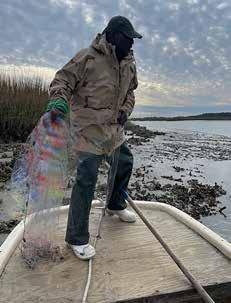
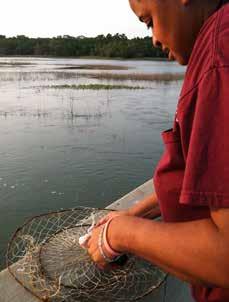
an umbrella term that describes the population and its language) “reject the poverty framework,” she said.
The Gullah frequently work outside of the typical capitalistic economy, as they “operate from an ideology of abundance” and fish in a sustainable manner that preserves their resourcerich tradition, Fuller said. Their lifestyle relies on multi-sited, multi-seasonal harvesting, a kinship network of distribution, and an understanding that “If a person has resources in the community, they are available to everyone.

“They fish every day, all day – in some way interacting with the waterway, even if they go off to another job for the rest of the day,” Fuller said. “It’s who they are – they fish, they crab, they shrimp, and then they share.”
Gullah culture also emphasizes the preservation of cultural knowledge, substantially retaining largely oral traditions from West Africa but co-mingling them with indigenous peoples in America.
Despite their multi-generational presence throughout the Lowcountry, with properties passed down from one generation to the next, Gullah communities and lifestyles face threats and challenges, Fuller said. Areas where they live and work are targets for resort development, which can limit their access to waterways. “What the Gullah hate most is to see fences
erected,” she said. “If Gullah homeowners are on the shoreline, all Gullah have access to the shoreline. That access is threatened when a resort comes in.”
Climate change – sea level rise, warmer water temperatures – also impacts Gullah practices. Warmer water means a shift in commercial fishing seasons, with a resultant impact on the Gullah economy. They also are losing some of their established fishing areas along the shoreline to erosion.
“The Gullah are not trying to establish sovereignty (over land),” Fuller said. “They want to be able to maintain their practices where they are. That doesn’t always mean they need ownership rights, just access. Their main concern is to be able to continue these practices that are intricately tied to the landscape.”
Fuller, who has been back and forth to the area since 2010, said it took her a while to fully develop trust with the Gullah, which came when she was able to spend longer stretches of time living among them.
“There’s a different way of existing within the United States that folks don’t recognize because they continue to graft one model onto all populations, and the Gullah have a very distinct way of existing that is communal. It is not based on a wage-based economy, but is reciprocal, sharing, and cooperative. This allows them to exist with a degree of autonomy in the spaces where they are,” she said.
- Jeff Keating
12
Dr. Sharon Fuller tries her hand at fishing with the Gullah community
Gullah fisherman
Dr. Sharon Fuller
In the News

Eclipse Megamovie a NASA & SSU Project
On April 8, the total eclipse of the sun was photographed by hundreds of public participants as it moved from Mexico to Maine and into Canada, through a project funded by NASA and led by Dr. Laura Peticolas, associate director of EdEon STEM Learning at Sonoma State University.
The crowdsourced collection of images will be stitched into a movie called the 2024 Eclipse Megamovie, and offer what Peticolas and the team call “a rare opportunity to study the secret lives of solar jets and plumes.” She helped lead the 2017 Megamovie project, which was the first crowdsourced collection of total eclipse images turned into a movie.
Leading up to the eclipse, the 2024 Megamovie was featured in science, mainstream, and academic media, including NASA, BBC and Science News, Smithsonian Magazine, Scientific American, NPR’s All Things Considered, Sky & Telescope, and the American Astronomical Society Bulletin.
Brent Hughes’ otter research in “Nature” captures national, international attention
Sonoma State University biology professor Brent Hughes’ research on sea otters and their role in protecting a California salt marsh was the cover article of “Nature” journal’s February 1 issue, called “Significant Otters.”
Against all odds, the biophysical features essential for making the Elkhorn Slough estuary a resilient coastal ecosystem are on the mend — in large part, the study appearing in “Nature” suggests, because of the sea otters’ insatiable appetite for plant-eating marsh crabs.
“When thinking about reintroducing sea otters outside their current range, salt marshes could be a very effective and affordable new tool for our conservation toolkit, benefitting both the sea otter and salt marsh,” lead author Hughes said of the study conducted over the course of a decade at Elkhorn Slough.
The story was picked up by nearly 200 news outlets in the U.S. and eight other countries, among them US News, Barrons, The Washington Post, ABC, CBS, and Fox News. Hughes was interviewed for an episode of a PBS docuseries, “Changing Seas” that is scheduled to air in June 2024.
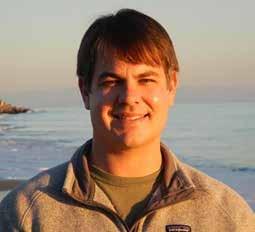

13 Insights Spring 2024
Image by Aurore Simonnet
Photo by Kiliii Yüyan
Brent Hughes

Dr. Ed Mills knew he had a big challenge ahead of him when he arrived at Sonoma State. In fact, he was counting on it — and welcomed it.
Mills, SSU’s Vice President of Strategic Enrollment Management, joined the university in August 2023 after 16 years at Sacramento State University, where he served in multiple roles, most recently as Vice President of Student Affairs and Chief Enrollment Officer.
At Sonoma State, he is charged with helping reverse enrollment declines that have left the university with about one-third fewer students than it had as recently as 2019. Enrollment throughout the California State University system is down 6.5% over that same period, so other CSU campuses face the same overall challenge, but SSU’s situation is especially acute.
So what was the appeal?
Mills — an Iowa native whose career started at Penn State University and led him to Cleveland State University before he joined the CSU in Sacramento — said it was his understanding and
Telling the SSU story
New VP Ed Mills believes student experience is key to future enrollment success
appreciation of SSU, its campus, and its people that made the prospect of leading enrollment here attractive.
”Not too long after Mike (President Mike Lee) had been appointed interim president, he asked me to come over and work with Provost Moranski and (former Senior Associate Vice President for Strategic Enrollment) Dr. Elias Lopez to do an assessment of enrollment and really look at what was happening, why there were successive drops over multiple years and what we could possibly do to stop that and turn it around.
“So when Mike approached me after (Elias Lopez) decided to retire, I already knew what the opportunity was here. I also was very familiar with Mike’s leadership, having worked with him at Sacramento State. And I thought, you know, if I could come and help turn around that enrollment story for such an amazing campus and put everything that I’ve learned over 38 years in higher education into making this a success story for our students, for our faculty and the university … well, who can turn down that kind of challenge?”
Mills said he is optimistic about SSU’s enrollment future because “I understand where the drop came from. If you go back to how this has been a campus that serves all parts of California, it’s a destination campus for students. And during the pandemic, students stayed close to home. So if you were a campus in a large metropolitan center, you fared much better than a campus in a smaller, more rural community like we are in.
“The challenge is that now we have multiple years of junior high and high school students that honestly have never heard of Sonoma State. And if they have, they don’t know where it is. So we have to reintroduce Sonoma State to California, to the western United States, and to the international population.
”It’s really about telling the story of what students can expect, the opportunities that they’ll find here, and what a great place this is.”
“His knowledge and experience in enrollment clearly is a fundamental reason he’s so important to us now,” said Karen Moranski, SSU Provost, Vice President
14
Dr. Ed Mills
for Academic Affairs, and Chief Academic Officer. “His demeanor really works well with people of all backgrounds. He’s a team player but also a leader -- people want to work with him. And he wants to make sure that a student who gets here has a great experience in learning; we want more students to have that experience.”
“And now we’re seeing the beginning of a good turnaround. Hope is now turning into numbers.”

Get to Know...
Dr. Kim D. Hester Williams
Professor of English and American Multicultural Studies
That turnaround is attributable to Mills’ experience and that of his team, but also to new tools and strategies.
“What’s exciting is that we get to tell our story in a whole new way,” Mills said. “Our student market is very different. They have very different sources of information. So it really gives us the opportunity to be cutting edge and to tell our story in ways that help students.”
- Jeff Keating
What I teach: My areas of expertise are early American and 19th Century American literature, African American literature and culture, and Women’s literature. I teach a variety of classes including early American literature surveys, American Authors, American Romanticism and Transcendentalism, Environmental literature and Ecocriticism, African American literature surveys, Women’s literature and culture including Feminist literature, and American Gothic and Horror literature and film.
How long have you been at SSU? I have been at Sonoma State since 1999.
Last book you read?
“The Bee Sting” (yeah, I know that’s an Irish book but it’s really good!).
Favorite show, movie, or podcast?
“Beef” (Netflix...so compelling re: nature, race, gender, ecology, and environment)
Favorite band or type of music?
Nina Simone and Beyonce!!! (I’m definitely a Bee Hiver!)
Why did you choose your field/profession?
I was motivated by a World literature class and professor I had at L.A. Community College shortly after high school. He was so enthusiastic and taught me to love literature…”Madame Bovary” was my favorite book in that class!
A memorable moment with students?
I think it is all of the awesome student presentations in classes like “Mark Twain” and in Gothic/Horror literature and film...students presenting in costume for the “Carrie” (Stephen King novel and subsequent ‘70s film)! Also, when I lectured on the character Rufus in Octavia Butler’s “Kindred” at Santa Rosa Junior College and a student came up afterward in tears. I’ll never forget that.
Why is SSU a good place to do what you do?
The students! Hands down the smartest, most conscientious, thoughtful, and wonderful people on the planet! I am good friends, besties actually, with a few former students from some years back during my tenure at SSU. SSU students motivate me every day, and they inspire me to be a good teacher and a good human being.
15 Insights Spring 2024
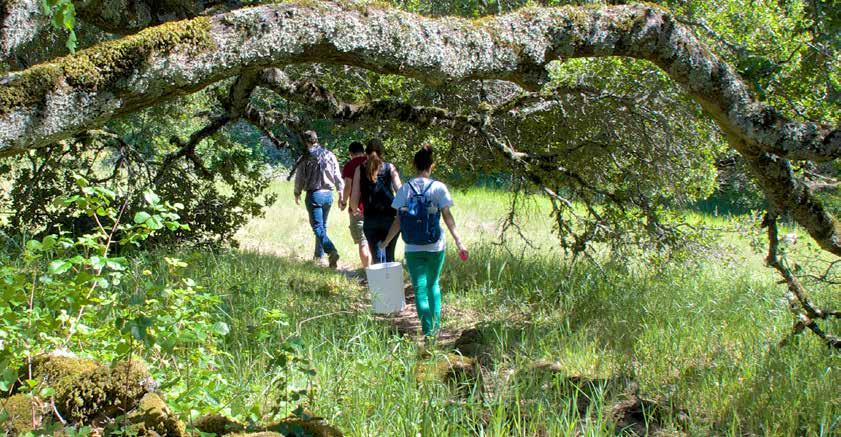
Preserving and renewing tradition
Tribe’s
gift to SSU
expands preserve facility, sustaining partnerships with purpose
Stories teach us that we are all connected and equal on this mountain - the humans, the plants and trees, birds, animals.
– from “How a Mountain Was Made” by Greg Sarris, Chair of the Federated Indians of Graton Rancheria and Sonoma State Distinguished Chair Emeritus
Where once the people living on Sonoma Mountain felt intrinsically connected to the land and all forms of life there, many children today don’t recognize nature, even when they are in it.
“You would be surprised at how often we show students a snake or lizard and they say, ‘It looks so real,’ because they’ve only seen them on screens before,” Student Naturalist Tessa Thompson said. “But when they hold a lizard, taste an edible plant or see a baby deer, they form an emotional connection to the environment, we hope, a desire to protect it.”
Protecting the environment and restoring connections to it – locally and writ large – is central to what is happening today at Fairfield Osborn Preserve, which occupies 450 acres on top of the mountain. Sonoma State has been stewarding the site since 1997.
Renewing ties
The ancestral homeland of indigenous peoples who are now citizens of the Federated Indians of Graton Rancheria, Sonoma Mountain is sacred and considered the place from which all life began. The tribe has sustained and passed on a reverence for the land and its preservation.
“The land is a treasure we need to pay back,” Sonoma State President Mike Lee said. “Our goal should be that every student – no matter what major – will develop the mindset to cherish and protect it.”
With that shared purpose, the FIGR and the university have developed an evolving, meaningful partnership to improve access to the preserve and mark its place in the history of the region’s earliest residents.
The newly opened Federated Indians of Graton Rancheria Learning Center is named in recognition of the tribe’s $2.8-million gift, which doubled the teaching/learning facilities, made them more accessible, and added an outdoor Listening Area.
The additional space will accommodate more on-site programs, which benefited 1,100 K-12 students and teachers and 3,500 total visitors in 2023. About 85 SSU students and community members are trained at FOP each year to lead educational tours and workshops, including those in Student Naturalist internships.
“The Center is our heart; it’s what connects us all,” said Chloe Winsemius, Preserve Education Assistant and Naturalist tour leader.
16
Fairfield Osborn Preserve
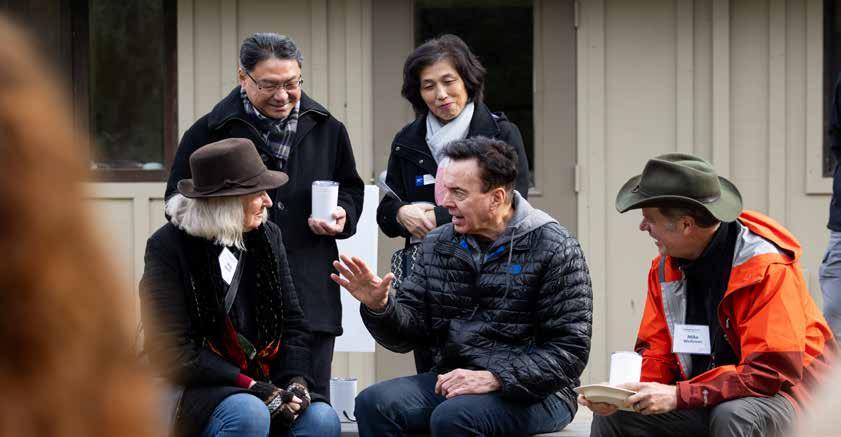
“We are excited to imagine how this space will inspire people to form more connections with nature, and with each other,” said Claudia Luke, Director of the Center for Environmental Inquiry, which oversees outreach, research, and education at FOP and two other preserves and gardens.
The new circular Listening Area reflects CEI’s value and practice of bringing together different cultures, disciplines, and generations to address community environmental priorities. Recent collaborations have focused on wildfire mitigation, air and water quality, biodiversity, and habitat restoration.
“Looking at challenges from diverse perspectives sparks innovation. We need new ways of thinking and doing to address environmental challenges and to find healing in ourselves and our communities,” Luke said.
Curing the ‘nature deficit’ and climate anxiety
“Bringing people to the preserve is key to reducing the ‘nature deficit’ affecting so many in our community, especially children,” said Thompson, who added that many student groups come from
urban or disadvantaged places where they have little or no access to nature.
“Many students are afraid because so much at the preserve is so new to them. But by the end of their visit, what we hear is ‘Can I stay? Can I come back tomorrow? Can I live here?’”
– Chloe Winsemius
Melia Zimmerman, who has interned for both the CEI Naturalist and Land Management programs, said spending time in nature makes her less anxious about the future.
“Climate anxiety is real for me and other members of the younger generations,” she said. But every single time I went to the preserve, I felt calmer because I knew I could contribute and have an impact here – even if I couldn’t control everything, everywhere.”
Luke said that the ultimate goal is to ensure every SSU student has an unforgettable experience in the environment before they graduate.
Thompson said she shares that message and encourages everyone she knows to visit Fairfield Osborn Preserve, “truly the greatest asset Sonoma State has.”
- Janet Durkin
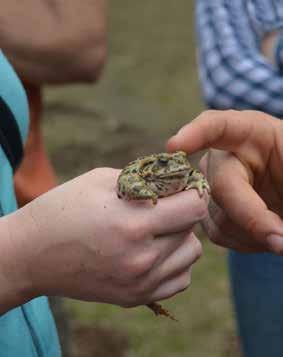
17 Insights Spring 2024
President Mike Lee and Fei Lee (standing) join Greg Sarris (seated, center) in discussion with guests at the opening of Federated Indians of Graton Rancheria Learning Center.
Naturalist tours introduce school groups to plants and animals.

SSU SEEDS sprouts community-minded teachers
The Seawolves to Education Specialists (SEEDS) program is creating more than just a new cohort of verdant, welltrained teachers. It’s broadening a heartfelt community of educators.
SEEDS launched in 2023 to support students in the SSU Special Education credential program under the co-direction of Elizabeth Ducy, SSU Associate Professor of Special Education, and Graduate Studies Coordinator Jennifer Mahdavi. The duo secured a $1 million federal grant for the program through the U.S. Department of Education Office of Special Education to increase the number of diverse credentialed special education teachers.
Ducy said she and her team regard having a disability as an added benefit to the human experience.
“We recognize that having a disability is an asset, and it is a rich variation of human diversity,” Ducy said, referencing the department’s philosophy and culture. “It also brings value to our classrooms and communities.”
The project aims to provide diverse credentialed special education teachers the training needed to serve children and youth with disabilities (ages 5-22). Its benefits include tutoring, advising sessions, professional development, and up to $22,000 in financial assistance.
“Our mission is to prepare teachers who are well-versed in meeting the academic, social, and behavioral needs of students with disabilities,” Ducy said. “But our larger goal is to build leaders in education who will support their students, their schools, their families, and also support each other and the project. It’s cyclical in nature.”
Struggling to navigate her prior college as a first-generation Latinx college student, Bianca LeMastern said she feels seen and supported as a SEEDS scholar. She hopes to one day be an example in her community, “For children of color who haven’t had teachers who look like them, I hope to say, ‘You can do this too.’”
18
SSU’s Special Education credential graduates are filling gaps in the qualified teacher pool locally and nationally.
Once SEEDS scholars finish their special education credential and are in their first year of teaching, Ducy said they will be invited to return and lead community meetings with new scholars.
Mahdavi recently attended a Special Education Local Plan Area advisory committee meeting where five of the 40 people in attendance were former students and are now district-level directors of special education or student services.
“Having known and taught these accomplished individuals at a formative stage and seeing them in leadership positions today was a profound privilege.” Mahdavi said. “What we do in our special education teacher program at Sonoma State has lasting positive ripples through our community.”
Special Education credential program graduates Meaghan King and Katya Robinson are heavily invested in what SEEDS grows. Both women have been named Sonoma County Teacher of the Year – Robinson in 2019 and King in 2023 – and now partner to advocate and support the project.
King, mentor to a SEEDS scholar doing fieldwork in her Herbert Slater Middle School class, said the project’s fellowship for new educators is essential.
“The program offers a vital community to new teachers. It is the heart of what we are doing with them,” said King, who is also the Extensive Support Needs department chair and teacher.
Robinson agreed with her colleague and said SEEDS and its cohorts are like one big family.
“There is a community in all we do, for the students, the school, the families, and the new teachers. That is what keeps our young teachers returning and why we have success with them,” she said.
Once a semester, the cohorts gather for SEEDS socials to foster connection.
“We just got together in December, and our agenda was to wrap the students in a warm hug,” Ducy said.
King said having students with disabilities is complex and challenging.
“You have to face things you would not have to when working with neurotypical kids. So having somebody next to you say, ‘You got this. I know what that’s like,’ is extremely valuable,” she said.
In the United States, 65 percent of classrooms are understaffed in special education. Programs like SEEDS are part of the solution to that problem.
“Special Education is the greatest world ever,” Robinson said. “The concept of SEEDS is so fulfilling and has wonderful implications for our students, teachers, families, and the whole community.”
- Krista Sherer
 SEEDS scholar Joana Lugo-Ramirez (right), reviewing student assessment data with her mentor teacher, Emily Mitchell.
SEEDS scholar Joana Lugo-Ramirez (right), reviewing student assessment data with her mentor teacher, Emily Mitchell.

Learning by Making
How a quest to transform science education put an SSU team ahead of the technology equity curve
Before cloud storage and critical updates that support browser connectivity to USB ports, SSU faculty, staff, and volunteers at EdEon STEM Learning built their own technology to innovate science teaching and took it to high school classes in rural and underserved schools.
Aptly named Learning by Making, the curriculum model has evolved and expanded for a decade, benefiting thousands of students at Ukiah, Point Arena, Round Valley, Roseland University Prep, and Southern Trinity high schools and recent new partners in Southern California, including Big Bear High School.
“Learning by Making has been our group’s most challenging project, but it also has the potential to transform STEM education nationally.”
– Dr. Lynn Cominsky Director and founder, SSU EdEon STEM Learning
Inspiration breeds invention
“We set out to create lessons to meet the science and engineering performance expectations set by Next Generation Science Standards” said Dr. Lynn Cominsky, who has been leading the curriculum development from the outset. “The problem was there was no affordable technology made for the classroom that could support our experiments.”
So, for the first five years, the EdEon team built the tech themselves – using custom chips and hand soldering. Cominsky’s late husband, Garrett Jernigan, invented an interactive cloud system tied to each classroom that was modeled after the system used when he built a small satellite with SSU undergraduates. They adapted the hardware platform to create the tools needed to teach technical elements of science practices, including coding, electronics, and sensors.
20
A Learning by Making student uses a digital Multimeter to measure voltage on his BasicBoard.
Taking it to the schools
Originally funded in 2013 by a $3 million grant from the U.S. Department of Education, Learning by Making was specifically designed to benefit rural schools, which Cominsky said are often underserved in STEM education. The integrated curriculum works well in schools with fewer science teachers, and the self-directed model serves a wide range of learners.
Ukiah teacher Greg Martin said the LbyM curriculum better engages all students, especially those not served by traditional practices. “One of my students had little interest in any of his classes. But he excelled in LbyM lessons and took it even further on his own by researching and building his own computer-controlled car.”
Claudia Harbour, who teaches at Trinity High School, said one student with reading comprehension difficulty needed help understanding the written directions to start LbyM lessons. “But once he engaged with the pictures and tech, he accelerated and became my right hand. It was the first time students were asking for his help,” she said.
Expansion into Southern California with large rural communities was made possible by a second, $4-million Department of Education grant and by commercially available technology to replace LbyM’s custom builds, said Dr. Laura Peticolas, SSU EdEon’s Associate Director and a principal curriculum developer.
“When Google came out with a way to use browsers to communicate with hardware connected to computers’ USB ports, we became able to support the curriculum at one-tenth the cost of the previously used custom laptops. That’s critical in underserved areas that don’t have tech in their classrooms,” she said.
Turtle by Turtle
LbyM lessons are 80 percent handson, teacher-supervised lab activities using a customized web app and the Logo programming language developed by MIT researchers, including project volunteer Brian Silverman.
Students learn to code in Turtle Logo within the LbyM Web App, then use it to connect to student-built electronic boards, ultimately to build experiments and analyze data from different sensors. In one lesson, they learn about a turtle’s life cycle and then, using those tools, they simulate the turtle’s movements based on real data obtained from GPS sensors. Subsequent hardware-based experiments use the Logo language to answer student-posed questions about energy and matter using soil moisture, temperature, and light sensors.
“LbyM is an exciting class to teach because there is something for everyone. Students practice logic and analytical thinking but can also be creative and expressive.”
– Derek Hoak Ukiah teacher
STEMACES: The New Frontier
With an infusion of $7.9 million from the Department of Education in 2023 –awarded based on successful leadership and data collected over 10 years – a new project has launched with the potential to reach thousands more rural and underrepresented students. STEMACES (Science, Technology, Engineering, Math and Computing Education Support) will apply elements of the high school LbyM curriculum for eighth-grade classes to six pilot schools in 2024-25 with the goal of bringing it into 20 schools each in California and Texas in subsequent years.
“We could provide long-term success data only because we had been integrating tech into the learning process before such tech existed, and could prove its effectiveness,” said Peticolas, who is Principal Investigator for the STEMACES grant.
Summarizing the team’s work, Peticolas said, “Our true goal is to teach foundational knowledge to a much larger group of learners in hopes that they will – when making decisions that would benefit from being scientifically literate – make informed decisions for their lives, their families, and their futures.”
- Janet Durkin
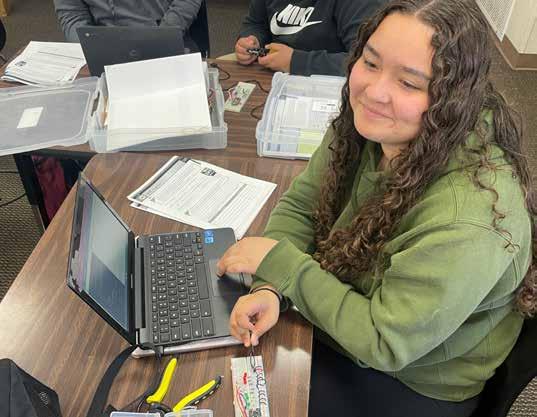 Another high school student covers part of the light sensor on her BasicBoard to determine which part of the sensor is detecting light.
Another high school student covers part of the light sensor on her BasicBoard to determine which part of the sensor is detecting light.
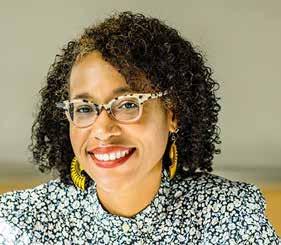
Get to Know...
Dr. Omayra Ortega
Associate Professor of Mathematics & Statistics, Assistant Dean of Research & Internships
What I teach: Primarily upper division statistics courses; also differential equations, mathematical modeling, and doing research with my undergraduate research group MERG.
How long have you been at SSU? I’ve been at SSU for a little over six years! The time has gone by so fast.
Last book you read?
“Losing the Precious Few: How America Fails to Educate Its Minorities in Science & Engineering” by Dr. Richard A. Tapia. This book is a great commentary from a seasoned veteran scientist from Rice University on the state of education and how it is still difficult – to impossible – for traditionally underserved Americans to succeed in STEM in this country, regardless of talent.
Favorite show, movie, or podcast?
For shows, I really like “Abbott Elementary,” “The Goldbergs,” or “The Secrets of Whales.” I just watched the Shirley Chisolm biopic starring Regina King, and it was amazing. As a native New Yorker, the Bodega Boys podcast will always have a special place in my heart.
Favorite band or type of music?
I listen to mostly electronic music – Theo Parrish, Bjork, and Machinedrum are some of my favorites. I like all kinds of music, but especially music that makes me think. I’ve admired The Kronos Quartet since high school and recently took my class to see them at the Green Music Center.
Sonoma State University Foundation Board
Executive Committee
Board Chair
David Felte, ‘01
Board Vice-Chair
Robert U’Ren
SSU Foundation CEO
Mario Perez
SSU Foundation COO & Secretary
Ian Hannah, ‘04 and ‘07
SSU Foundation CFO
Amanda Visser
Members
Monir Ahmed
Frank Chong
Anita Christmas, ‘89 and ‘92
Taylor Frickman
Cassandra Garcia
Thomas Gillespie, ‘74
Joseph Huang, ‘02, ‘04 and ‘18
Tom Isaak, ‘66
Why did you choose your field/profession?
Honestly, I’ve always loved mathematics because it is a field that studies and chronicles the pattern, beauty, and order that exists everywhere. Since graduate school, I have started teaching and doing more research in statistics. I became a professor because I enjoy interacting with people, learning, and traveling, all of which are required parts of my job.
A memorable moment with students?
I took a group of five students to the National Association of Mathematicians annual Undergraduate MATHFest at Clark Atlanta University in Atlanta, Ga. in fall 2023 and had the best time watching these students enjoy the conference and take in all of the student research projects. Because we had a multi-hour delay on our flight home, we got to process everything we’d learned over a shared meal. I really enjoyed that unstructured time with my students.
Why is SSU a good place to do what you do?
Because of our diverse student population and students who motivate me every day. Students who come here are eager and humble and really want to learn. The education SSU provides can change a student’s whole life, and I appreciate working at a place that can do so much good for society.
Brigitte Lahme
Ming-Tung “Mike” Lee
SSU President
H. Andrea Neves
Ernesto Olivares
Kenneth “Randy”
Pennington, ‘85
Marcela Piedra
Ali Pourghadir, ‘05
Travis Saracco, ‘12
Maraskeshia Smith
Michael Sullivan
Brent Thomas, ‘92
22
Sonoma State University Foundation Board
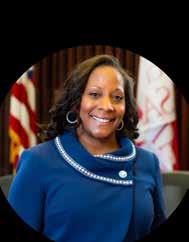
SSU Foundation New Board Members
MARASKESHIA SMITH
City Manager of Santa Rosa
Maraskeshia Smith is the first African American woman to take on Santa Rosa’s City Manager role since 2022. Before this pivotal role, Maraskeshia served as Deputy City Manager of Stockton, where her responsibilities spanned economic development, human resources, municipal utilities, and initiatives addressing affordable housing and homelessness. She has been dedicated to nonprofit organizations focused on youth education and development. Maraskeshia was acknowledged for her achievements with her selection as one of the 2023 North Bay’s Influential Women. She holds a Master of Business Administration from Eastern Kentucky University and a Bachelor of Science in Business Administration from the University of Kentucky.
ERNESTO M. OLIVARES


Community Safety Consultant
Ernesto M. Olivares has over 45 years of public safety experience, including over 30 years as a law enforcement professional and 17 years leading efforts in youth safety and violence prevention. Ernesto served on the Santa Rosa City Council for 12 years, including a term as mayor. Before his election to the Council, Ernesto was a lieutenant with the Santa Rosa Police Department, where he retired in 2008. Ernesto has served as a consultant helping communities develop comprehensive and strategic violence prevention plans, that include cities such as Long Beach, Santa Maria, Santa Barbara, Goleta, Carpinteria, and Hagerstown, Maryland. Currently, he is assisting the City of Santa Rosa in updating its Violence Prevention Partnership Strategic Plan.
MARCELA PIEDRA
City Manager of Rohnert Park
Marcela Piedra began working as the City Manager of Rohnert Park in 2023. She has 20 years of municipal management experience as well as executive leadership, which includes serving as Deputy City Manager, Community Services Director, Director of Economic Development, and Redevelopment Manager for the City of El Centro. She has extensive involvement coordinating and overseeing community and economic development, redevelopment, housing, community services, and cultural activities. Marcela has an Associate of Arts degree in Business with an emphasis in Business Administration from Imperial Valley College. She earned a Bachelor of Arts degree in International Business, with an emphasis in Spanish and Latin America, from San Diego State University, Imperial Valley Campus, and a master’s degree in Business Administration from the University of Phoenix.
FRANK CHONG

Former Superintendent/President Emeritus at Santa Rosa Junior College
Prior to joining Santa Rosa Junior College as President/Superintendent in 2012, Frank Chong served as the Deputy Assistant Secretary for Community Colleges in the U.S. Department of Education. He has previously served as president of Laney College, President of Mission College, Dean of Student Affairs at San Francisco City College, special assistant to Mayor Willie Brown of Oakland, speaker of the California Assembly, and he has been an administrator for multiple nonprofit organizations. Chong currently serves on the boards of Pepperwood Preserve and the Sonoma County Health Alliance, and is a former president and founding member of the national advocacy organization of Asian Pacific Americans in Higher Education. Chong has a doctorate in education from Dowling College, a master’s In public administration from Harvard Kennedy School, and bachelor of arts in Social Welfare/Asian American Studies from the University of California in Berkeley.
23 Insights Spring 2024
Alumni News

Letter to Alumni Community
Dear Sonoma State University Alumni Community,
I’m thrilled to reconnect with you through the pages of “Insights.” Let me express my sincere gratitude for your continued support and engagement with your alma mater. Your contributions, whether through mentorships, philanthropy, or simply staying connected with fellow alumni, are instrumental in shaping the future of our university community.
Within these pages, you’ll find updates on upcoming events, volunteer opportunities, and ways to stay connected with your fellow alumni. Whether you’re looking to reconnect with old friends, expand your professional network, or give back to your alma mater, there are many ways for you to engage.
We invite you to share your own stories, updates, and achievements with us for future editions of the magazine or through digital media. Your experiences and insights are invaluable not only to our alumni community but also to current students who look to you for inspiration and guidance.
Please stay connected, engaged, and proud of the impact you have made and continue to make as alumni of Sonoma State University. If you have any questions, suggestions, or would like to get involved, please do not hesitate to reach out.
I look forward to hearing from you and working together to shape the future of our alumni community.
Tiffany O’Neil, ‘96
Assistant Vice President Alumni Relations and University Engagement alumni@sonoma.edu

Alumni Association Board of Directors
President
Elizabeth Payan, ‘14
Senior Program Director
Napa Valley Transportation
Authority
President Elect
Rich Shayewitz, ‘00 and ‘16
Head Men’s
Basketball Coach
Sonoma State University
Immediate Past President
Travis Saracco , ‘12
Director of Partner Success
Bay Area Digital Solutions
Secretary Caroline Neyman, ‘10
Senior Director of Operations
Green Music Center
Treasurer
Randy Ferino, ‘01 and ‘06
Vice President/ Employee Relations and Employment Manager
Exchange Bank
Directors
Derek Bradley, ‘14
Director of Belonging, Education and Support
Sacramento State University
Jeff Fuller, ‘07
Real Estate Agent
Excellerate Real Estate
Taylor Frickman
Associated Students Liaison
Sonoma State University
Christina GonzalezGamboa, ‘19 and ‘23
Accountant
Delicato Family Wines
Cerbelio Grijalva Reyes, ‘18 and ‘23
Bilingual Clinician Mental Health Associate
North Marin
Community Services
Laura McCarter, ‘04
Software Engineer
Keysight Technologies
Tyler Osburg-Head, ‘12
Estate and Sales Manager
Martin Ray Vineyards and Winery
Holden Reyes, ‘19
Associate Director of Student Life and Assistant Instructor
UC Berkeley - Haas
Business School
Brad Yust, ‘76
Commercial Real Estate
Board Liaisons
Joseph Huang, ‘02, ‘04 and ‘18
CSU Alumni Council
Representative
Vice President, Senior Business Development Officer
BMO Bank
Staff
Tiffany O’Neil, ‘96
Assistant Vice President, Alumni Relations and University Engagement
Amy Paterson, ‘20
Alumni Engagement Analyst
24
2023/24 SSU
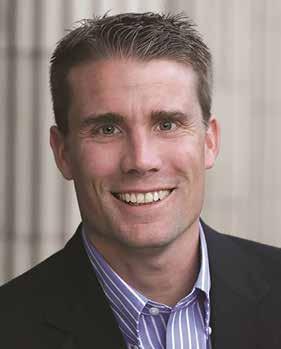
Alumni Spotlight: Senator Mike McGuire
Mike McGuire (BA, Political Science, 2002) is a third-generation Northern Californian whose family farmed Sonoma County’s Alexander Valley for nearly a half century. He was elected to the Healdsburg School Board at 19 – while a college student – and served on the Healdsburg City Council as the youngest mayor in city history. He was elected to the Sonoma County Board of Supervisors in 2010, and then to the state Senate in 2014, representing the Second Senate District. He took office as Senate President Pro Tempore in February 2024.
What attracted you to Sonoma State University when you were considering colleges?
The North Bay has been my family’s home for four generations now, and Sonoma State is a gem in our own backyard. It truly never crossed my mind to go anywhere else. At the time, I was serving on the school board and working full time, so it was a natural fit. Attending SSU was a life-changing experience. The education was incredibly rigorous and the professors and staff are some of the best in America who constantly go the extra mile for their students. On the personal side, I made friendships that will last a lifetime and I met my wife at SSU, which I’m forever grateful for.
What is the first thing that comes to mind when you think about the university today?
Sonoma County and the North Bay are so incredibly lucky to have an institution like Sonoma State as a pillar in our community. For decades, SSU has made the North Bay stronger by graduating some of the brightest minds in Northern California. These graduates go on to contribute in amazing ways to the communities they call home. I feel so grateful to have had Sonoma State in my life.
How do you view SSU’s place in today’s higher ed environment?
Sonoma State is a beautiful and integral part of the 23-campus CSU system, and a beacon of high-quality public higher education here in the Golden State. It’s come a long way since its founding in 1961, and I could throw a lot of stats in here, like the university offering 49 majors and having one of the only wine business programs in the country. But honestly, I think what makes SSU one of a kind is the students, faculty, and staff. Yes, it’s an absolutely stellar university, yes, it’s set in a gorgeous and welcoming community, but it’s the people who make it shine. They are the heart of Sonoma.
What was the best thing that happened to you while attending SSU?
Meeting my wife Erika! She didn’t talk to me when we first met, which made it pretty damn awkward. But eventually I was able to convince her to grab a burger, and the rest is history. Erika is not only the best thing to happen to me while at Sonoma State, but the best thing to ever happen to me, period. And we couldn’t be more thrilled to have Connor (aka Corndog) now. He’s our amazing hell on wheels 3-year-old who is the center of our family’s universe.
What can alumni do to help the university, and how can the university continue to be of assistance to its graduates?
Get involved! There is so much value in connecting with the next generation of students. Some folks choose to financially contribute to their alma maters and that’s absolutely laudable, and others may choose to reconnect in different ways –either through a mentorship, jumping into a campus improvement project, or being a guest lecturer. Do what feels comfortable for you, but whatever you do, give back. There is so much virtue in connecting with this storied campus and the students who are the heart of the university, especially supporting students from underserved communities.
Any words of wisdom for SSU’s newest graduates?
Commencement is truly a special time in life and it gives you the ability to imagine your life in different ways! As soon as that diploma hits our hands, it’s tempting to run as fast as we can in one direction, and not want to veer away from it. But life comes at you fast, and sometimes what becomes important is the ability to pivot and reimagine possibilities.
And for me, what’s always stuck and served me well is the advice my grandma kicked down: Work hard, work together, and never take no for an answer for the issues you believe in.
25 Insights Spring 2024
Ambrose R. Nichols, Jr. Scholar
2023-24 Recipient, Michelle Jones

Named after the founding president of Sonoma State University, The Ambrose R. Nichols, Jr. Scholarship was established to honor a Sonoma State junior, senior, or graduate student who exemplifies distinguished scholarship and outstanding contributions to the university and community.
Michelle Jones’ passion for reading began at the earliest of ages, when she insisted on learning to read books herself. She credits her freshman English teacher at Montgomery High with igniting the first spark in turning her fervor for the subject into a career goal.
“Although my desire to pursue a graduate degree in English literature was nearly suffocated under the debris of a turbulent late teens and early/mid twenties, an abundance of oxygen-rich enthusiasm was reintroduced by my English 1A instructor,” Michelle said. She completed her degree at SRJC and continued on the path to fulfilling her dreams of becoming a college English educator.
Since transferring to Sonoma State in autumn of 2020, Michelle has completed her B.A. in English (Literature Concentration) and is now in her second year of SSU’s M.A. in English program, with an emphasis in Literary Criticism. Her area of specialization is Feminist Disability Studies in 20th and 21st century American literature. “This emphasis unites my passion for social justice with my personal identity (as a blind woman), and wraps it all up neatly with a bow of contemporary American literature,” she said.
Michelle currently works as a Teaching Associate in the SSU English Department and is also a writing tutor in SSU’s Writing Center. She will complete her M.A. in Spring 2025, with the intention of continuing her education by pursuing a Ph.D. in either English Literature or Interdisciplinary Humanities.
Heart of SSU Alumni Scholarship
2023-24 Recipient, Megan Bressel
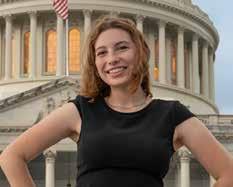
Established in 2015 by the SSU Alumni Association, this scholarship provides a complete year of tuition for Sonoma State students who wouldn’t otherwise be able to attend college. The scholarship recognizes students with strong academic performance who have demonstrated commitment to the campus and community and embody the spirit of Sonoma State.
Megan Bressel is a first-generation college student in her third year studying political science at Sonoma State. She was born and raised in Sonora, California, a rural small town in the Sierra Nevadas. Megan has been active on campus as a member of the Educational Opportunity and TRIO programs. She serves as the president of SSU Mock Trial, as an event director with Associate Student Productions, and is a member of Sonoma Senders rock climbing club.
“In addition to my coursework, I spent a summer working as a congressional intern in Washington, D.C., for my home district’s congressman,” Bressel said.
She says that she has had numerous opportunities to give back to her community as an Eagle Scout with Scouts BSA (The Boy Scouts of America) and as part of the inaugural class of female Eagle Scouts.
“In my spare time, I operate a small business on various online reselling platforms. I am truly passionate about being able to operate my own enterprise while attending school,” Bressel said.
26
Giving Day
Thank you for making this year’s Giving Day a huge success! Together, we are making a difference and building a brighter future for our campus community
funds supported $430,117 was raised to support programs and iniatives at SSU givingday.sonoma.edu
include:
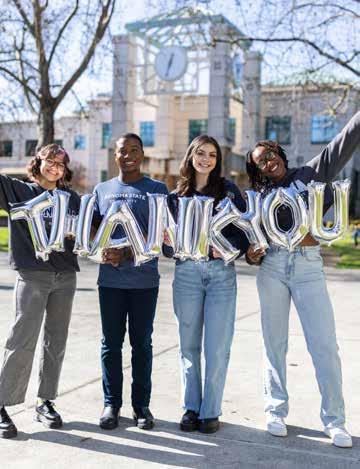
Your decision to include Sonoma State in your will, trust or other planned gift is worth celebrating. Inform us of your plans and join the 185 others in our Nichols Legacy Society. Or, let be a resource as you consider your legacy. We are happy to help. If you have made a planned gift, or are considering one, contact Adam Jarman, associate vice president, at (707) 664-2070 or jarmana@sonoma.edu . Information and tools are also available on our website at plannedgiving.sonoma.edu
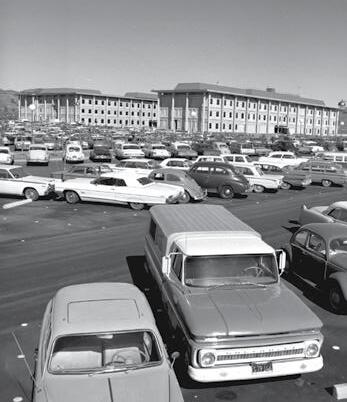


27 Insights Spring 2024
#ALLFORSONOMASTATE
157
321 alumni donors 326 first-time donors
Which
Your legacy is worth celebrating Nichols Legacy Society
Event Round Up
We’ve had so much fun connecting with Sonoma State alumni at our recent events! Alumni engagement events provide a space for our graduates to connect with peers across different years, professions, and industries.
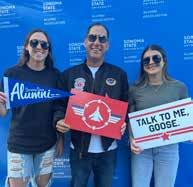

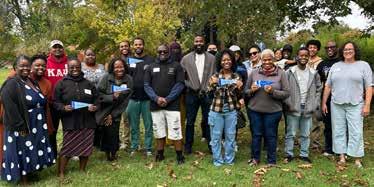



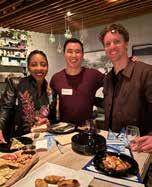
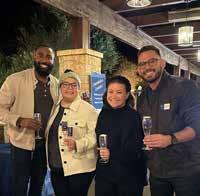

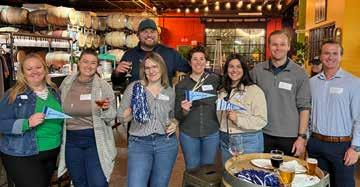

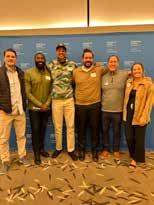
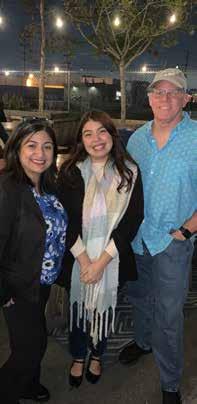

28
•
•
•
•
•
•
•
•
•
•





29 Insights Spring 2024 JOIN US AT AN UPCOMING ALUMNI EVENT! Sonoma State Network Your SSU-only online networking and mentoring platform BENEFITS:
Exchange ideas with like-minded individuals
Connect with alumni and professionals in your career field
Develop long-lasting personal relationships
Give back to your community through mentoring
Get support from professional connections
Learn about career opportunities
Speak with alumni with similar backgrounds
Get career advice and support
Develop leadership skills
And so much more For support or questions, contact sonomastatenetwork@sonoma.edu. Join today to get your free access www.ssualumni.org Location: Salazar Hall 1053 Phone: 707-664-2426 Email: alumni@sonoma.edu
Class Notes
1960s

Ralph Jaeck, ‘67, ‘74, and ‘75 since his retirement has been traveling extensively all over the world with his wife and currently serves as the Osher Lifelong Learning Board at the University of Nevada, Reno.
1970s
Robert Earle, ‘72 is a professor at Central Oregon Community College.
Robert Nielsen, ‘76 has been retired from the Food Manufacturing and Sales Industry since 2017 and is currently involved in local government and volunteering.
Chris Redner, ‘72 works in sales at PromoShop Branded Products.
Richard Sandvick, ‘71 is a sales manager at State Compensation Insurance Fund.
Elaine Scheer, ‘79 has retired from the Art Department at the University of Wisconsin as a Emeritus Professor after 34 years.
Lynn Underwood, ‘76 is an art therapist and Coach at Artful Interventions.
1980s
Charles Kerns, ‘80 has written five books, developed computer-based learning tools, worked on the Sakai Course Management system and worked for Apple for five years in the Advanced Tech Group on multimedia in Education.
Michael York, ‘87 is the assistant men’s soccer coach at Sonoma State University.
1990s
Laura Chalmers, ‘96 is an associate professor at OU Health.
Robert Marc Fero, ‘96 is a massage therapist at Golden Haven Spa.
Michael Henry, ‘90 works at Bellarmine College Prep and is a licensed marriage and family therapist.
Deana Hernandez, ‘98 is an executive assistant as VMware.
Barbara Ibarra, ‘99 is a Department of Justice Accredited Representative at VIDAS.

Gregg Jann, ‘94 is the owner of Jann Demystifying Affects, a Consultant for NAMI Sonoma County, and a blogger. He has written five business & social science books, with Jann’s 5th titled in early 2023 on Business source rights of economic money value of Intellectual Property making history, including design of the internet in Non-Fiction format claiming. Mr. Jann was a former F.W. Woolworth Co. Manager of a store as a Sr. Assistant and Trainee in San Francisco, and after Sonoma State spent 10 years as a MH Counselor performing duty of care in Group Homes, not housework but counseling tasks for independence and some emotional after many years in a locked environment due to senior aging, homelessness, and Serious Mental Illness. Gregg Jann was elected to Piner-Olivet Union School District from 98-2005, and developed a Teach Peace ballot suggestion from a Character Ed school board goal. During this election time, he worked on source perspective design of the Mental Health Services Act CA Fall ‘04 in suggesting the tax funding mechanism and his own explaining the legality of categorical income taxes right in his meetings with the lobbyist in Sacramento planning committees. He also extended union inclusion of worker rights to a disenfranchised workforce of MH consumers and all line staff at CSN through SEIU as Lead Negotiator. Gregg Jann is a Founder of “Reconciling” Christianity, at least voting for it in his Methodist Church a few years after graduating.
Angela Lam, ‘94 is a creative writing instructor at Gotham Writers’ Workshop.
Sokpha Lim, ‘98 is an Administrative Assistant at JSCO.
Matt Lillig, ‘98 is the senior manager of Data and Analytics at Blue Shield of California.
Laura Lorrain, ‘98 is a medical receptionist at Advance Physical Therapy.
Michael Vermeys, ‘96 is the assistant field manager at the DOI - Bureau of Land Management.
*Ryan Young, ‘93 is the lead care manager at Molina Healthcare.
2000s
Nina Alejos, ‘06 and her husband Charley met in high school, graduated from SSU together in 2006, got engaged, bought a house in 2008 in Petaluma, and have two kids and a dog. She became a CPA and most recently a tax manager at Pisenti & Brinker, LLP.
Paul Baker, ‘06 is a video manager at Google.
Ryan Bruinsslot, ‘01 is the CEO for R Bruins, Inc. a construction company and has traveled to Italy and Greece, lived in Hawaii and continues to embrace life’s adventure.
Whitney Hahn, ‘05 is a payments certification specialist at Stripe.
Loren Lucelle, ‘04 is a foster parent and business owner who travels the world.
Elizabeth Pope, ‘05 is the director of advocacy and services for Placer Independent Resource Services. They are one of 28 Independent Living Centers across the state of California who provide services for people with disabilities. They promote individuals to live independently and on their own in their community. She enjoys ultra trail running and races and trains with a trail running program through Fleet Feet Sports based in the Sacramento region. She also does yoga, plays guitar and writes music.
30
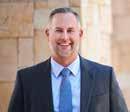
Brett Rhodes, ‘00 and ‘04 is an attorney and founder of Rhodes Law. After graduating, Brett pursued advanced studies at Empire College School of Law, obtaining a master’s degree in legal studies and a Juris Doctorate. In 2020, he founded Rhodes Law, an estate planning law practice in Sonoma County, CA. Brett’s admission to practice law in California, followed by admissions to the U.S. Northern District of California, U.S. Court of Appeals for the Ninth Circuit, and the United States Supreme Court, underscore his legal expertise within our community. Brett was featured in Super Lawyers magazine and recognized in the 2024 Northern California Rising Stars list, placing him among the top 2.5% of attorneys in Northern California demonstrating excellence in his field. In addition to his legal career, Brett has over two decades of progressive experience in public service. He currently serves as the Chief Deputy Public Administrator for the County of Marin and has been appointed to the Executive Board representing the State Association for his discipline. Previously, he held various law enforcement roles, including Chief of Police for a federally commissioned agency. Brett graduated from the FBI LEED’s 46th Command Institute for Law Enforcement Executives, Dominican University’s Leadership Program, and the National Association of Counties (NACo) High Performance Leadership Academy. Brett also serves as associate faculty at the Santa Rosa Junior College, Public Safety Training Center, where he helps develop the next generation of law enforcement officers. He also speaks at SSU’s Prelaw Society, Empire College School of Law, and other professional platforms, discussing public administration, leadership, and the legal field. Brett’s dedication to community service is evident through his impactful charitable work, positively impacting many in our community. He remains committed to inspiring and supporting others to pursue their dreams with passion and perseverance while making meaningful advancements in his field in the years ahead.
Katherine Sandoval, ‘04 is the AVP of Leasing Services at Macerich.
Niki Scioli, ‘07 and ‘09 is a Partner and Producer for Zan Media.
2010s
Amelia-Marie Altstadt, ‘17 is an honors coordinator at the University of Nebraska-Lincoln.
Kellie Douglas, ‘17 is a campus confidential advocate at Sonoma State University.
Corey Handa, ‘18 is a tasting room lead at Gallo.
William Hekman, ‘19 is now a federal advocacy associate at Vectis DC.
Jiana Jaber, ‘17 is the director of talent management at MGM Resorts International.
Kia Kolderup-Lane, ‘12 is the senior manager, State and Local Government Affairs at Salesforce.
Patrick Maloney, ‘14 is the lead generation operations manager at BILL and recently purchased a home in Sacramento.
Hayley Marx, ‘12 is a marketing manager at Hilton Los Angeles, Culver City.
Andrew Munson, ‘13 is a teacher at Nava College Prep Academy.
Heather Radovich, ‘13 is now the alumni engagement coordinator/production manager at Moreau Catholic High School.
Nicole Stevens, ‘12 is the senior manager of Inside Sales and Support at Tempest Telecom Solutions.
Katherine Tempel, ‘12 is a recruiting manager at CyberCoders.
2020s
Caroline Adams, ‘22 previously served as the Communications and Content Manager at Hanna Center. She recently relocated to Seattle, WA to pursue new opportunities.
Jenna Barber, ‘23 is a substitute teacher for the Oakley Union Elementary School District.
Zachary Bibeault, ‘23 is a Medical Assistant at Healthy Living Primary Care. There, he is gaining experience to apply to physician assistant (PA) school.
Olivia Blades, ‘23 is a Before and After Care Assistant at Cleveland Elementary School. She is applying for graduate programs at Wake Forest University for a Masters in Clinical Counseling.
Hayden Byers, ‘23 is a bartender at Cinnabar Hills.
Serina Cabrera, ‘23 drove across the country and started her Masters of Science in Cardiovascular Epidemiology Program at Harvard T.H. Chan School of Public Health.
Daphnee Cardoza, ‘23 is the Event Coordinator and Tasting Room Associate at Williamson Wines. She recently studied abroad in Denmark and traveled to Prague and New York.
Yun-Huai Chen, ‘23 is a peer recovery coach at Telecare Corp.
Abigail Cody, ‘22 is a Classroom Coordinator at the Anova Center of Education. She has also been snorkeling on vacation in Mexico.
Jennifer Copeland, ‘23 is the Director of Preschool Programs at Community Child Care Council of Sonoma County.
Haley Costa, ‘20 Is a People Experience Coordinator at Arctic Wolf.
Kevin Norton, ‘20 is a Graduate Assistant at the University of Nevada, Reno, pursuing his PhD in Economics.
Louis Davis Jr., ‘22 is completing his MBA with a specialization in human resources and getting married in 2024. He has released multiple Hip Hop and RnB albums. He has also been recognized at the Top Mobile Expert Sales Representative in California and has achieved the Winners Circle Award. Louis also coaches his son’s football and lacrosse teams.\
Natalya DeArman, ‘23 is an account manager at Milliken & Company.
Andre’ Dews, ‘22 is a Media Services Technician at Santa Rosa Junior College. He works for the San Francisco 49ers, San Francisco Giants, Golden State Warriors and Petaluma Community Access.
Yasmin Esquivel, ‘23 is a Youth Impact Assistant at the Boys and Girls Club of Sonoma-Marin.
31 Insights Spring 2024
Class Notes
Azucena Ferrusca Lopez, ‘23 is a social/ personal assistant at Valentine Brothers, spreading positivity and advocacy on Down Syndrome.
Alyssa Ford, ‘23 is the senior instructional assistant at the Charter Academy of the Redwoods. She is also entering theTeach Lake County credential program to work towards a mild to moderate special education credential.
Paola Garcia, ‘23 is an enologist at Plata Wine Partners.
Aldena Garrett, ‘23 is a registered nurse for Providence.
Allan Gomez Blancas, ‘23 obtained a full time tax position with his accounting degree.
Sonia Gonzalez, ‘20 is a Management Aide for the County of Santa Clara.
Daisy Gutierrez, ‘22 and ‘23 is a teacher for the Soledad Unified School District.
Abigail Harr, ‘23 is an elder law caseworker for the Legal Aid of Sonoma County.
Jared Height, ‘23 is an assistant archivist at the Charles M. Schulz Museum and Research Center.
Natalie Heissenbuttel, ‘23 is a production assistant for the Golden State Warriors, after being promoted from the Oakland Athletics organization as a production assistant to technical director. She is also a dealership photographer.
Adilene Hernandez Perez, ‘22 works as an ABA therapist and behavioral technician where she gets to work with clients who are on the autism spectrum and who have intellectual abilities. She also interns for the Latino Service Providers and the Sonoma County Office of Education.
Kevin Janas, ‘23 is an Operating Room Nurse. He also has his BLS, ACLS, and PALS certifications. Kevin also serves as the PTA Vice President for Buckingham Collegiate Charter Academy.
Nicolas Johnson, ‘22 is a Community Service Officer at Santa Rosa Junior College.

Jill Kawakami, ‘22 is a Judicial Fellow at the Superior Court of California, Nevada County. Jill works in the field of court administration and data analysis. Jill was recently engaged to her partner of 11 years and moved to Grass Valley, CA.
Laura Lacalle, ‘22 has continued her education at the University of Denver for her Masters in Social Work.
Sophia Larsen, ‘22 is currently a graduate candidate at Cranbrook Academy of Art.
Zoe Martinez, ‘22 is a Social Media Coordinator for CASA of San Benito County. She also has a digital website design company.
Emily Miller, ‘21 is an Account Executive at Swing Strategies and serves as the Vice President of the Republican Staffers Association. She recently completed the prestigious California Senate Fellowship, Class of 2022 and is a Capital Women’s Fellow Scholarship recipient.
Stacie Nakapaahu Harper, ‘23 is an ERSS for the Solano County H&SS.
Molly Oates, ‘22 is the General Manager of Frontier Airlines.
Amy Paterson, ‘20 is the Alumni Engagement Analyst at Sonoma State University.
Davi Peterson, ‘22 is a chemist.
Lindsay Pfeiffer, ‘22 is the owner of Bay Laurel Solutions - a small branding agency.
Yessenia Resendiz Torres, ‘23 is a domestic violence case worker for the Legal Aid of Sonoma County.
Cassandra Rojas Barrios, ‘22 is a Social Emotional Support Specialist at Wu Yee Children’s Services. She was recently promoted and is pursuing graduate school.
Dorothy Rose-Miller, ‘23 is the Lead Registered Behavioral Technician at Shalamo Home.
Sarah Scrivano-Ceja, ‘23 is a teacher for Santa Rosa City Schools.
Audrey Shiomoto, ‘22 and ‘23 is a teacher at San Jose Unified School District.
Emille Smith, ‘13 and ‘23 is the Grants Coordinator for the Sonoma County Indian Health Project, Inc.
Robert Tah-Cauich, ‘23 is the Co-Owner of his family-owned business: Esquivel Roofing Co.
Emma Thomas, ‘23 is a specialist at Apple. She is working on the application process for graduate school programs to further her educational career.
Cesar Torres, ‘23 is a chemistry technician at LGC Biosearch Technologies.
Alex Vargas, ‘22 is an apprentice technician for Americas Tire.
Calista Vazquez, ‘22 is an educator within the Los Angeles Unified School District.
Madeline Warner, ‘23 is a cashier for Walt Disney Company.
Seawolf Born, Seawolf Wed
Scott Hardie, ‘06 married Brittney Kleiman on April 23, 2023.
Patrick Maloney, ‘14 married Courtney Atchley, ‘14 were married in 2021.

32
1801 East Cotati Ave
Rohnert Park, CA 94928
A campus of the California State University
CHANGE SERVICE REQUESTED
SONOMA STATE UNIVERSITY IS...
PERSONAL
Average class size is 26 STUDENTS 1:18 Faculty to student ratio
SUCCESSFUL
in four-year graduation rate of first-time, first-year students #5 in transfer graduation rate #2
Best College in nation for transfer students (Money Magazine) 12th
2023 Cal State Equity Champion for Latinx students
AFFORDABLE
Ranked among the Top 100 Affordable Public Schools nationally* greatvaluecolleges.net t
73% of students receive financial aid
47%
Hispanic Serving Institution since 2017 of students will be first in their family to graduate from a 4-year university
DESIRABLE AS A HOME ACCESSIBLE
#1 in CSU for university housing


































 SEEDS scholar Joana Lugo-Ramirez (right), reviewing student assessment data with her mentor teacher, Emily Mitchell.
SEEDS scholar Joana Lugo-Ramirez (right), reviewing student assessment data with her mentor teacher, Emily Mitchell.

 Another high school student covers part of the light sensor on her BasicBoard to determine which part of the sensor is detecting light.
Another high school student covers part of the light sensor on her BasicBoard to determine which part of the sensor is detecting light.





































